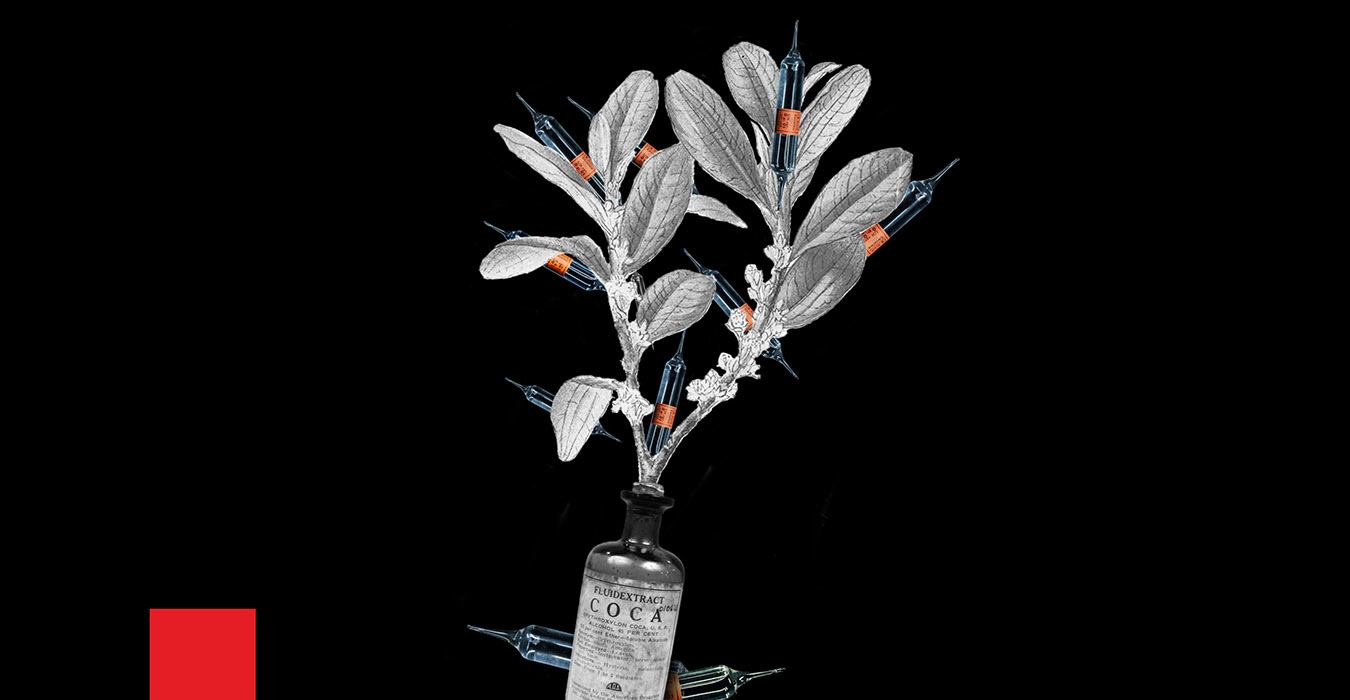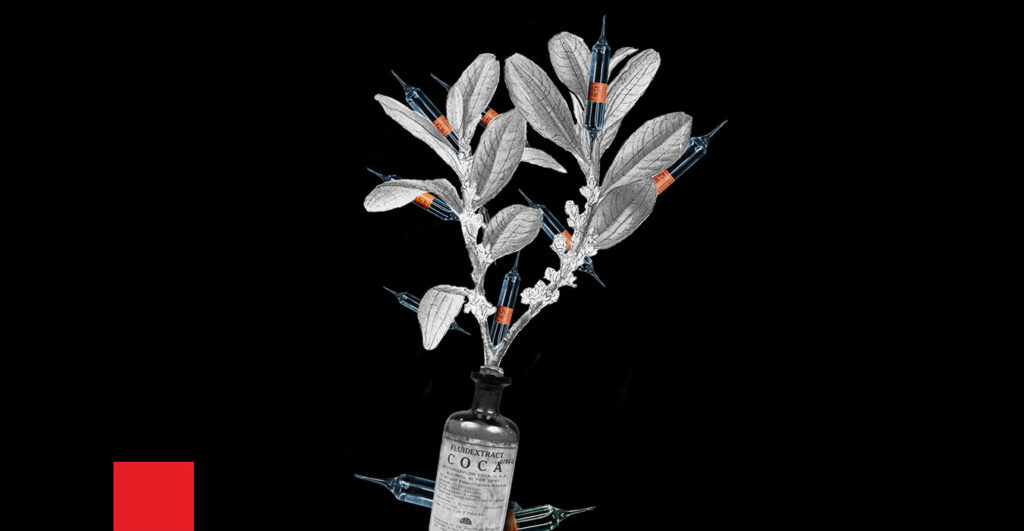
Text: Josefina Salomón / Ilustration: Sergio Ortiz Borbolla
1. “Magic” plant. The history of cocaine as we know it today begins with its main ingredient, the coca leaf, a South American plant that has been cultivated mostly high in the Andean mountains of what is now Peru, Bolivia and Colombia for at least 3,500 years. The word “coca” comes from the amyara, a pre-Inca language, and played an important role in sustaining the Inca empire, the most powerful in South America before the Spanish conquest.
2. Indigenous peoples chewed the deep green leaves in religious ceremonies and used them as a painkiller, to increase energy, control hunger and cope with high altitudes where oxygen is limited. The plant was so important to the locals that it is believed to have played an important role in the construction of many of the long roads that helped sustain the Inca empire for so long.
3. “Agent of the Devil”. This is how the Spanish conquistadors described the plant when they arrived in the area that is now Peru in the 16th century. But things took a quick turn when the Europeans realised that, without it, the locals found it difficult to work the fields and mines and went from prohibiting it to regulating its consumption. They began paying indigenous workers in coca and even taxing it. American crops were very popular in Europe, but it took a while for coca to become one of them, probably because most people there were reluctant to the idea of chewing leaves.

1. New technology. Everything changed in the 19th century, when European scientists succeeded in isolating alkaloids from plants that offered enormous medical – and commercial – opportunities. First came morphine, which was extracted from opium in 1803, then quinine and caffeine around 1829, and nicotine in 1833. In 1855, the German chemist Friedrich Gaedcke was able to isolate the alkaloid responsible for the main properties of coca leaves. A few years later, Gaedcke’s 26-year-old student Albert Niemann perfected the method as part of his doctoral thesis and named the substance “cocaine”. But it was not until 1883, when a German military doctor, Theodor Aschenbrandt began using it on soldiers, claiming it made them stronger, that cocaine was really born.
2. Über Coca. This is the name of the first of several articles that the then young physician Sigmund Freud published in 1884, after trying cocaine as a treatment for the chronic fatigue and depression that afflicted him. He wrote that cocaine produces “lasting euphoria, which differs in no way from the normal euphoria of the healthy person…”. A year later, in 1885, the chemist Henry Hurd Rusby formalised a method of manufacturing cocaine paste in Latin America, which made it cheaper and easier to transport.
3. Miracle medicine? Cocaine took off, big time. Doctors began prescribing it to combat almost any ailment, from asthma, nipple pain, syphilis and, believe it or not, opium addiction. A coca leaf-infused Bordeaux wine invented by a French chemist was an instant hit, with admirers said to include Thomas Edison and the Russian Tsar. The wine is believed to have been the inspiration for the original Coca Cola, which contained nine milligrams of cocaine per glass as one of its ingredients until 1928.
4. Free for all. Artists praised the white powder. Robert Louis Stephenson is believed to have written “The Strange Case of Dr. Jekyll and Mr. Hyde” after using cocaine for six days. In 1916, the British department store Harrods sold a kit called “gift for friends at the front” which included cocaine, morphine and needles. The business potential around cocaine was so good that, in the late 19th century, the Dutch took the plant to the island of Java (then a colony, now Indonesia), and to Ceylon (Sri Lanka), as well as to Formosa (then a Japanese protectorate, now Taiwan). The idea worked. Java became one of the world’s largest coca growers in the 1920s. The Dutch were forced to stop growing the plant because of global controls.
1. Everything that goes up… Must come down, particularly after a few doses of cocaine. Over the years, the addictive, and destructive, properties of the drug began to become apparent. In the first two decades of the 20th century, medical associations began to turn their backs on it and the list of products containing cocaine dropped dramatically. The United States led the charge, with Dr. Hamilton Wright at the forefront of the often racist campaign. Experts say this toxic rhetoric, which still has great impact, struck a chord with the white population. In the 1920s, countries began to impose laws restricting availability, and a pervasive informal market was born.
2. Debut on the big screen. Cocaine use declined dramatically in the decades that followed, as marijuana and LSD became favourites among the youth of the 1960s. In fact, in 1957, the head of the US Federal Bureau of Narcotics and father of punitive policies, Harry Ansinger, claimed that his country did not have a cocaine problem. It was short-lived. Things changed again in the 1960s, when the white powder came back into the limelight. Peter Fonda and Dennis Hopper brought it to the big screen in “Easy Driver“, while the New York Times, Newsweek and Rolling Stone described cocaine as harmless and glamorous.
3. War on drugs. It was the strategy adopted in 1971 by then President Richard Nixon to deal with what he called “public enemy number one”, and it changed history forever. It resulted in increased investment in law enforcement and a rapid rise in incarceration rates and, yes, you guessed it, especially targeting ethnic minorities. It was just the beginning. A decade after Nixon, Ronald Reagan took the campaign to the next level, promoting militarization and mass incarceration of low-level dealers and consumers.
4. The white decade. Cocaine defined the 1980s. It was cheap, high quality and easy to get. It was the social glue that defined a decade of discotheques and money hunger, as capitalism was king. The US backed its policies with money and power. The Drug Enforcement Administration (DEA) was flush with cash. But this was also the era of the massification of crack, a cheap (and extremely destructive) type of cocaine. It was then that attention and opinion shifted. The US media began to warn about the impact of the crack epidemic and the particularly damaging effect on marginalised communities. Newsweek went so far as to compare it to the “Vietnam War”.
1. The South. The 1980s was also the beginning of the golden age of criminal organizations. The Medellín Cartel (yes, the one led by Pablo Escobar) saw the huge business opportunity of controlling cocaine production and distribution (through organizations in Mexico) and grabbed it with both hands, growing in money and power using brutal violence. When Escobar was assassinated in 1993, the adaptability and resilience of criminal markets was laid bare.
2. Cali. As it turned out, while the world (well, the United States) focused all its money, military might and attention on hunting Escobar down, his rival, the Cali Cartel, evolved as a much stronger and more resilient organization. They forged alliances with the police, governments and the military, essential arrangements for conducting any illicit business. Learning from their Medellín counterparts, they dispensed with individual charismatic leaders and instead opted to work as a network, with small independent cells covering the main territorial areas.
3. Mexico. When the US government increased pressure on Colombia with asset seizures and extraditions of high-profile drug lords, Mexican criminal organizations, which had been transporting cocaine across its long border with the United States for years, saw an opportunity to control the business. The history of Mexico’s criminal organizations is intertwined with the country’s history and its complex relationship with the United States. It is a history marked by entrenched corruption in government and security forces, petty rivalries between criminals, much bloodshed and an absence of justice for the hundreds of thousands of people caught in the crossfire. Over time, the Mexican organizations, each in their own right, managed to gain a foothold in the global criminal world.
4. Adaptability. This is the main characteristic of today’s criminal organizations, allowing them to survive and continue to grow in the face of any government strategy. The fact that some very high profile arrests (yes, El Chapo) barely make a dent in drug production, supply and use, and violence mainly in Latin America, is testimony to the power of these organizations to adapt and survive.